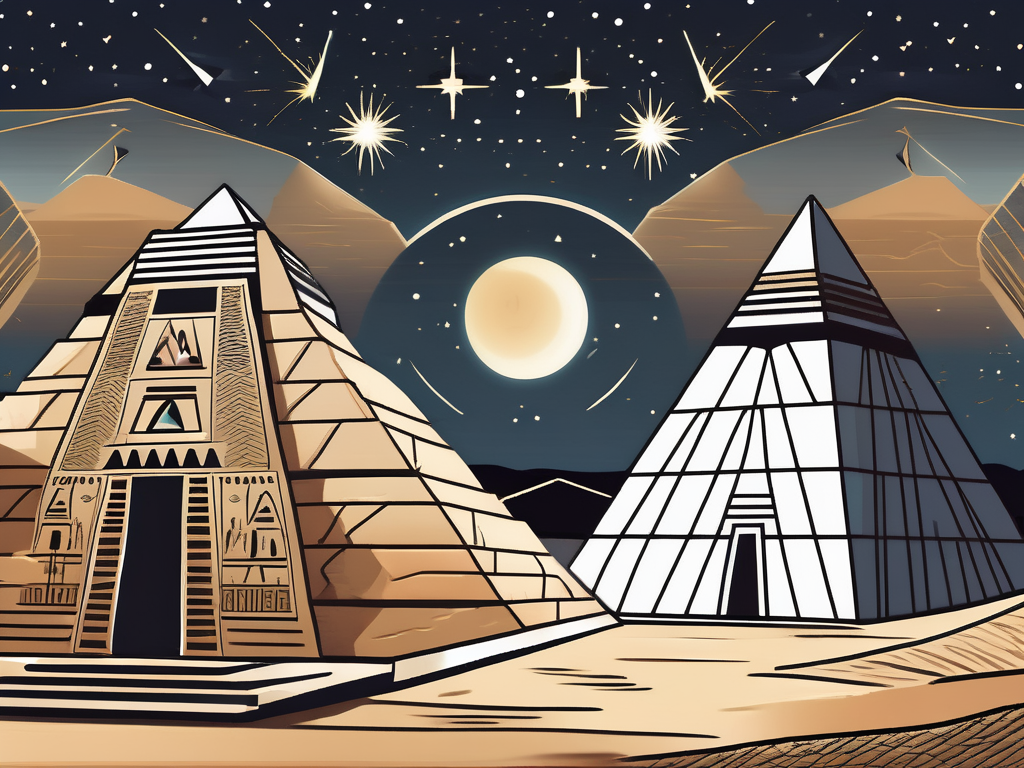Have you ever wondered about the fascinating myths and legends surrounding the mighty Nile River? One prominent figure that emerges from ancient Egyptian mythology is Anqet, the enigmatic God of the Nile. In this article, we will delve into the rich history and captivating tales surrounding Anqet, exploring their association with the Nile, their influence on ancient Egyptian society, the symbolism and iconography attributed to them, their position within the Egyptian pantheon, the worship and rituals dedicated to Anqet, and their lasting legacy in modern culture.
Understanding Anqet’s Role in Egyptian Mythology
Anqet holds a significant place within ancient Egyptian mythology, particularly due to their close association with the sacred Nile River. This deity was believed to govern the annual flooding of the Nile, which played a crucial role in the agricultural prosperity of the kingdom.
Legend has it that Anqet was responsible for ensuring the river’s recurrent floods, which irrigated the fertile lands of Egypt and fostered the growth of crops essential for sustenance. The Egyptians held Anqet in high regard, attributing the abundance of their agricultural harvests to their divine intervention and protecting influence over the Nile.
Anqet’s Association with the Nile
Anqet’s connection to the Nile River was deeply ingrained in Egyptian culture. They were often depicted as a youthful goddess, adorned with a headdress composed of upright ostrich feathers, symbolizing fertility and growth. The flowing waters of the Nile were believed to embody Anqet’s energy, carrying with them life-sustaining properties.
The ancient Egyptians believed that Anqet resided in the cataracts of the Nile, the rocky rapids where the river descended. They believed that these tumultuous waters were a reflection of Anqet’s power and assertive nature, often depicted as a lioness or a lioness-headed goddess, emanating strength and protection.
Furthermore, Anqet’s association with the Nile extended beyond its role in agriculture. The river served as a vital transportation route, connecting different regions of Egypt and facilitating trade and communication. Anqet, as the guardian of the Nile, was believed to ensure safe passage for boats and protect travelers from any harm that may befall them during their journey.
Anqet’s Influence on Ancient Egyptian Society
The unique role of Anqet in ancient Egyptian society extended beyond their association with the Nile. As a powerful deity associated with water, Anqet also held sway over fertility, a concept central to Egyptian beliefs. The waters of the Nile symbolized the cycle of life, death, and rebirth – a spiritual embodiment of the eternal cycle of existence.
Apart from their influence on the agricultural prosperity of the kingdom, Anqet also played a vital role in ensuring the well-being and prosperity of the ruling pharaoh. It was believed that through their divine presence, Anqet protected the pharaoh from harm and bestowed upon them the authority to govern effectively.
Moreover, Anqet was often invoked in rituals and ceremonies related to fertility and childbirth. Expectant mothers would seek Anqet’s blessings and protection, believing that their intervention would ensure a safe and successful delivery. The goddess was also associated with the protection of children, and parents would offer prayers and offerings to Anqet to safeguard their offspring from harm.
Additionally, Anqet’s influence extended to the realm of medicine. The ancient Egyptians believed that the goddess possessed healing powers, particularly in relation to water-borne diseases. Temples dedicated to Anqet often had sacred pools or wells, where individuals would seek purification and healing by immersing themselves in the blessed waters.
Overall, Anqet’s role in Egyptian mythology was multifaceted and encompassed various aspects of life and society. From their association with the Nile and its agricultural significance to their influence on fertility, protection, and healing, Anqet held a revered position in the hearts and minds of the ancient Egyptians.
The Symbolism and Iconography of Anqet
The fascinating symbolism and mesmerizing iconography attributed to Anqet offer further insights into their revered status within ancient Egyptian culture. Artistic representations of Anqet often depicted them alongside other deities, emphasizing their role as a significant figure within the Egyptian pantheon.
Anqet’s Depiction in Ancient Art
In ancient Egyptian art, Anqet was typically depicted in a human or semi-human form, often bearing the distinctive features of a lioness. These depictions captured the essence of Anqet’s power, strength, and protective qualities, emphasizing their connection to the Nile and agricultural abundance.
Sculptures and reliefs portraying Anqet would depict them pouring water from a large vessel, symbolizing their responsibility for the Nile’s annual inundation. These artistic representations aimed to communicate Anqet’s role as a divine intermediary between the natural world and humanity.
The Symbols Associated with Anqet
Alongside their representation as a lioness-headed goddess, Anqet was closely associated with various symbols in ancient Egyptian culture. The ostrich feathers adorning their headdress represented fertility and growth, while the sacred ankh symbol, often held in their hands, signified life and eternal existence.
In addition to these symbols, Anqet was also connected to the “was scepter,” which represented power and authority. The scepter was often depicted alongside Anqet, serving as a reminder of their role in protecting the pharaoh and ensuring the prosperity of the kingdom.
Anqet’s Place in the Egyptian Pantheon
Within the complex tapestry of ancient Egyptian mythology, Anqet occupied a unique position within the pantheon of gods and goddesses. While their primary association was with the Nile, they also forged significant relationships with other deities and played essential roles in mythological stories.
Relationships with Other Egyptian Gods
One of the notable mythological relationships involving Anqet was their connection to the god Khnum, the creator of life and the potter of human beings. It was believed that Anqet, Khnum, and the goddess Satis formed a divine triad responsible for the creation and sustenance of life in the Nile Valley.
Additionally, Anqet also shared a relationship with the goddess of love and fertility, Hathor. This connection symbolized the union between the life-giving properties of the Nile and the creative energies associated with love and procreation.
Anqet’s Role in Mythological Stories
Mythological narratives often depicted Anqet as a key character in stories concerning the creation of the Nile and the interactions between gods and mortals. Their presence in these tales signified the vital role they played in maintaining the delicate balance between the natural forces that influenced the kingdom’s prosperity.
One such story revolved around the god Hapi, personifying the annual flooding of the Nile. According to legend, Anqet aided Hapi in controlling the flow of these floods, allowing the river to provide the life-giving waters essential for the thriving civilization along its banks.
Worship and Rituals of Anqet
The worship and rituals dedicated to Anqet provide insight into the deep reverence and respect the ancient Egyptians held for this divine figure. Temples and shrines were built in honor of Anqet, providing a space for devotees to express their devotion and seek their blessings.
Ancient Temples and Shrines Dedicated to Anqet
One of the most significant religious centers dedicated to Anqet stood at the island of Seheil, located near the first cataract of the Nile. This temple, known as “Satis-Anqet,” was a place of pilgrimage for those seeking Anqet’s favor and seeking protection from the Nile’s potentially destructive power.
Within the temple, elaborate rituals were conducted by priests to appease and communicate with Anqet. These rituals involved offerings of food, drink, and incense, accompanied by prayers and hymns praising the deity’s immense power and benevolence.
Ritual Practices in Honor of Anqet
Besides the grandeur of the temple rituals, individuals also sought personal connections with Anqet through smaller, intimate rituals. Devotees believed that by bathing in the waters of the Nile, they could establish a direct connection with Anqet and gain their favor.
Special ceremonies and processions were held during key events such as the Nile’s annual flood, symbolizing the close connection between the deity and the life-sustaining waters. These rituals aimed to maintain harmony with the divine forces and ensure the continued abundance of the Nile’s blessings.
Anqet’s Legacy in Modern Culture
Although the ancient civilization that revered Anqet has long since passed, their influence continues to resonate in modern Egyptian culture. Anqet’s prominent role in shaping the Egyptian identity and their enduring legacy can still be observed in various forms of artistic expression and literature.
Anqet’s Influence on Modern Egyptian Identity
The symbolism and cultural significance associated with the Nile River, intrinsically linked to Anqet, remain an essential part of the Egyptian national identity. The Nile’s connection to fertility, agricultural prosperity, and the cycle of life is deeply ingrained in the collective consciousness of the Egyptian people.
Furthermore, Anqet’s portrayal as a protective deity and their association with strength and power continue to inspire and influence contemporary Egyptian society. The lioness-headed goddess represents qualities of resilience and resourcefulness that resonate with individuals as they navigate the challenges of the modern world.
Anqet in Contemporary Art and Literature
Anqet’s powerful presence has also found expression in contemporary art and literature. Artists draw inspiration from ancient Egyptian depictions of Anqet, reimagining and reinventing them in various visual mediums. Writers and poets explore the captivating narratives surrounding Anqet, infusing them with modern nuances and interpretations.
Through these artistic endeavors, Anqet’s legacy endures, allowing people of all backgrounds to appreciate the rich cultural heritage of ancient Egypt and find inspiration in the mythical tales that shaped their understanding of the world.
In Conclusion
As we journeyed through the captivating world of Anqet, the Egyptian God of the Nile, we discovered the profound influence they held over ancient Egyptian society. From their association with the Nile’s life-giving waters to their symbolization of strength and protection, Anqet’s impact extended far beyond the realm of mythology.
Through the worship and rituals dedicated to Anqet, the ancient Egyptians sought to establish a connection with the divine forces that governed their existence. Today, Anqet’s legacy lives on, inspiring individuals to appreciate the significance of the Nile River and embrace the qualities of resilience and resourcefulness that this lioness-headed deity embodies.
So, next time you gaze upon the mighty Nile, remember the tales of Anqet, the ancient god who commanded the floods and secured the prosperity of a civilization. Their mythological presence forever etched into the annals of time, enduring as a testament to the enduring power of Egyptian mythology and the profound reverence for nature that defined one of the world’s greatest ancient civilizations.












